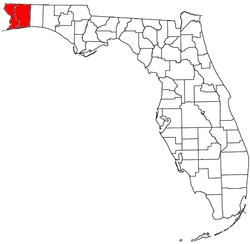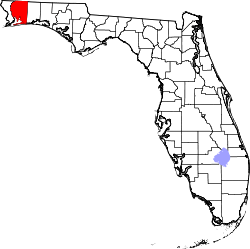Milton, Florida
| Milton, Florida | |
|---|---|
| City | |
|
Santa Rosa County Courthouse | |
 Location in Santa Rosa County and the U.S. state of Florida | |
| Coordinates: 30°37′49″N 87°2′47″W / 30.63028°N 87.04639°WCoordinates: 30°37′49″N 87°2′47″W / 30.63028°N 87.04639°W | |
| Country |
|
| State |
|
| County | Santa Rosa |
| Area | |
| • Total | 4.6 sq mi (11.8 km2) |
| • Land | 4.4 sq mi (11.3 km2) |
| • Water | 0.2 sq mi (0.5 km2) |
| Elevation | 33 ft (10 m) |
| Population (2000) | |
| • Total | 7,045 |
| • Density | 1,531.5/sq mi (597/km2) |
| Time zone | Central (CST) (UTC-6) |
| • Summer (DST) | CDT (UTC-5) |
| ZIP Code | 32570, 32571, 32572, 32583 |
| Area code(s) | 850 |
| FIPS code | 12-45750[1] |
| GNIS feature ID | 0286947[2] |
| Website | City of Milton |
Milton is a city in Santa Rosa County, Florida, United States.[3] The city was incorporated in 1844 and is home to Naval Air Station Whiting Field. The population was 7,045 at the 2000 census. In 2004, the population recorded by the U.S. Census Bureau was 8,044.[4] The population estimate for 2013 was 9,323.[5] It is the county seat of Santa Rosa County. Milton was known by various names during its development. Most notable were "Jernigan's Landing", "Scratch Ankle" (due to the briars that grew along the riverbank), "Hard Scrabble", and later Mill Town because of the lumber mill which eventually shortened to Milton.[6]
Milton is part of the Pensacola–Ferry Pass–Brent Metropolitan Statistical Area.
Geography
Milton is located at 30°37′49″N 87°02′47″W / 30.630312°N 87.046486°W.[7]
According to the United States Census Bureau, the city has a total area of 4.6 square miles (12 km2), of which 4.4 square miles (11 km2) is land and 0.2 square miles (0.52 km2) (4.59%) is water.
Demographics
| Historical population | |||
|---|---|---|---|
| Census | Pop. | %± | |
| 1860 | 1,815 | — | |
| 1870 | 1,014 | −44.1% | |
| 1880 | 1,058 | 4.3% | |
| 1890 | 1,455 | 37.5% | |
| 1900 | 1,204 | −17.3% | |
| 1910 | 831 | −31.0% | |
| 1920 | 1,594 | 91.8% | |
| 1930 | 1,466 | −8.0% | |
| 1940 | 1,851 | 26.3% | |
| 1950 | 2,040 | 10.2% | |
| 1960 | 4,108 | 101.4% | |
| 1970 | 5,360 | 30.5% | |
| 1980 | 7,206 | 34.4% | |
| 1990 | 7,216 | 0.1% | |
| 2000 | 7,045 | −2.4% | |
| 2010 | 8,826 | 25.3% | |
| Est. 2015 | 9,628 | [8] | 9.1% |
At the 2000 census,[1] there were 7,045 people, 2,674 households and 1,831 families residing in the city. The population density was 1,611.1 per square mile (622.4/km²). There were 3,151 housing units at an average density of 720.6 per square mile (278.4/km²). The racial makeup of the city was 67.84% White, 25.95% African American, 0.71% Native American, 1.73% Asian, 0.17% Pacific Islander, 1.04% from other races, and 2.56% from two or more races. Hispanic or Latino of any race were 3.45% of the population.
There were 2,674 households of which 33.9% had children under the age of 18 living with them, 49.7% were married couples living together, 15.6% had a female householder with no husband present, and 31.5% were non-families. 27.2% of all households were made up of individuals and 12.0% had someone living alone who was 65 years of age or older. The average household size was 2.51 and the average family size was 3.04.
27.3% of the population were under the age of 18, 8.9% from 18 to 24, 28.2% from 25 to 44, 18.8% from 45 to 64, and 16.8% who were 65 years of age or older. The median age was 34 years. For every 100 females there were 86.2 males. For every 100 females age 18 and over, there were 81.1 males.
The median household income was $37,629, and the median family income was $44,261. Males had a median income of $35,000 versus $28,337 for females. The per capita income for the city was $19,367. About 11% of families and 16.7% of the population were below the poverty line, including 20.2% of those under age 18 and 11.7% of those age 65 or over.[10]
City information
Santa Rosa Medical Center (SRMC) is a 129-bed general hospital in Milton. SRMC is the primary provider of hospital-based healthcare services and emergency medicine in Santa Rosa County.
Milton is the home of the West Florida Railroad Museum and the historic Imogene Theatre owned and operated by the Santa Rosa Historical Society.
History
Milton was settled in the early 1800s as a small village centered on the lumber industry. The settlement was originally known as "Scratch Ankle", because of the briars and bramble that grew in the area.[11] Another name was "Jernigan's Landing", after Benjamin Jernigan (died April 1847), who built a water-powered saw mill at what is now Locklin Lake between 1828 and 1830.[12] Other names were "Lumberton", "Black Water" and "Hard Scrabble", but by 1839, it was being referred to as "Milltown".[13] Milton was incorporated as a city in 1844, one year before the Territory of Florida joined the United States as the 27th state.[11]
During the Civil War, much of Milton was burned by Confederate forces retreating from the Union capture of Pensacola in May 1862. The Confederates intended to prevent the town's industries from falling into Union hands. After the Southern forces evacuated the Union troops had a small garrison in nearby Bagdad where they had a base for expeditions in the surrounding area. [14] Many Milton residents fled to Alabama.[11]
Naval Air Station Whiting Field was constructed during World War II with the help of many German prisoners of war who were housed in a camp on the site. The station was commissioned on July 16, 1943 by Rear Admiral George D. Murray and the widow of Captain Kenneth Whiting, after whom the station was named.[15]
On March 31, 1962, an F3 tornado hit the northwest side of Milton, causing 17 deaths and 100 injuries. It was Florida's deadliest tornado until February 22, 1998, when 25 people were killed in Kissimmee.[16] It was also the deadliest tornado in 1962.[17]
Notable people
- Mark Everett – A former professional sprinter. He was born in Milton and graduated from Milton High in 1986.
- Daniel Ewing – A former NBA guard who is currently playing for Maccabi Ashdod of the Israeli Premier League
- Cortland Finnegan – A cornerback for the Tennessee Titans, the St. Louis Rams, the Miami Dolphins, and the Carolina Panthers. He graduated from Milton High in 2002.
- Bruce Hall – A former NFL running back/special teams for the Buffalo Bills and the Denver Broncos. He graduated from Milton High School in 2003.
- Dayton Hobbs – A founder and pastor of an independent Bible church in Milton, putative creator of Tee Ball.
- Bolley Johnson - A former Speaker of the Florida House of Representatives.
- Nick Monteleone – A film and television composer, arranger and musician. He graduated from Milton High in 1996.
- Reggie Slack – A retired quarterback of the National Football League and Canadian Football League. He graduated from Milton High in 1986.
- Heath Slocum – A professional golfer on the PGA Tour. He graduated from Milton High in 1992.
- Lawrence Tynes – A former placekicker for the Kansas City Chiefs, the New York Giants, and the Tampa Bay Buccaneers, Tynes is currently a free agent. He graduated from Milton High in 1996.
- Casper Van Dien – An actor who was born in Milton.
- Bubba Watson – A professional golfer on the PGA Tour. He was born in nearby Bagdad, Florida and graduated from Milton High in 1997. He won two Masters.
- Boo Weekley – A professional golfer on the PGA Tour. He was born in Milton and graduated from Milton High in 1992.
- Elijah Williams – A former cornerback for the Atlanta Falcons. He was born in Milton and graduated from Milton High in 1993.
References
- 1 2 "American FactFinder". United States Census Bureau. Retrieved 2008-01-31.
- ↑ "US Board on Geographic Names". United States Geological Survey. 2007-10-25. Retrieved 2008-01-31.
- ↑ "Find a County". National Association of Counties. Retrieved 2011-06-07.
- ↑ Annual Estimates of the Population for Incorporated Places in Florida, Listed Alphabetically: April 1, 2000 to July 1, 2004
- ↑ http://factfinder.census.gov/faces/tableservices/jsf/pages/productview.xhtml?src=bkmk
- ↑ Santa Rosa Historical Society
- ↑ "US Gazetteer files: 2010, 2000, and 1990". United States Census Bureau. 2011-02-12. Retrieved 2011-04-23.
- ↑ "Annual Estimates of the Resident Population for Incorporated Places: April 1, 2010 to July 1, 2015". Retrieved July 2, 2016.
- ↑ "Census of Population and Housing". Census.gov. Retrieved June 4, 2015.
- ↑ "American Community Survey results for Milton, FL 2007-2011". United States Census Bureau. Retrieved November 13, 2013.
- 1 2 3 "History of Milton, FL". www.ci.milton.fl.us. 2 April 2012. Retrieved 23 February 2015.
- ↑ "Santa Rosa Press Gazette, February 15, 2008 - City of Milton ordered to stop damage to Jernigan Mill". genforum.genealogy.com. Retrieved 23 February 2015.
- ↑ Green, Laurie (1998), Santa Rosa County, Arcadia Publishing, ISBN 978-0752408750 (p. 7)
- ↑ Elisa Mitchiner (November 2010). Niceville, Florida Online History Center http://boggyflorida.com/Niceville/CivilWar.html. Retrieved 20 January 2014. Missing or empty
|title=(help); External link in|website=(help) - ↑ "NAS Whiting Field". www.militarybases.us. Retrieved February 23, 2015.
- ↑ http://www.tornadoproject.com/alltorns/worstts.htm
- ↑ http://www.tornadohistoryproject.com
External links
| Wikivoyage has a travel guide for Milton, Florida. |
| Wikisource has the text of a 1905 New International Encyclopedia article about Milton, Florida. |
- City of Milton
- The West Florida Railroad Museum
- Santa Rosa Press Gazette newspaper that serves Milton, Florida available in full-text with images in Florida Digital Newspaper Library
- The Milton Chronicle provides analysis of issues relating to Milton, Florida.


